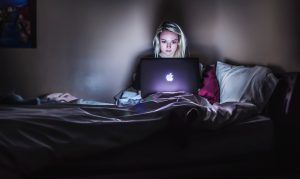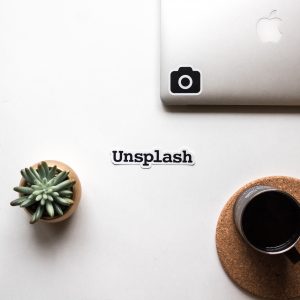Posts in Category: Class Reflections
Virtual Reality!
What a crazy thing!
I had tried virtual reality (VR) once before at Pacific School of Innovation and Inquiry. The process involved putting on a pair of goggles and then proceeding to convince myself that the plank I was standing on was not actually on top of a sky scraper and if I were to fall I wouldn’t actually fall to my death. Even though I knew that to be true, it still felt terrifying. The only way I could walk the plank was by going down onto all fours and rolling off. Yes, my classmates laughed. My heart was 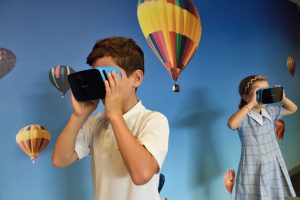 racing and my palms were sweaty even after finishing the challenge.
racing and my palms were sweaty even after finishing the challenge.
UVic Experience
My experience at UVic last week was not as intense. It was lighter introduction to the VR world. However, I did become nauseous and had to put the device down earlier than I wanted to. Apparently women are more likely than men to feel motion sickness in VR. Here’s a related article that argues motion sickness in women to be caused by posture –> https://www.newscientist.com/article/2115648-posture-could-explain-why-women-get-more-vr-sickness-than-men/ .
At UVic, I flew around Google maps, exploring European castles and tropical beaches, and occasionally shooting off into outer space. It was pretty neat but unfortunately (fortunately?) lacked the “thrill” of my first experience. This time around my VR experience was more about enjoying the scenery and learning about different geographic locations, rather than pushing my physical and mental body to the limit.
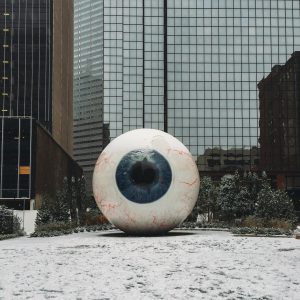
VR in Education
I could see VR beingused as a educational tool. However, I did learn that anyone under the age of 13 years old should not use VR, and those between the ages of 13-15 can use it but should do so sparingly. I could see VR being used in an art room to help render 3D models before they’re actually brought to life, and could also provide a space for students who want to work B I G but don’t have the capacity to due to lack of funds, time, etc. These students could build their work in VR and then show the class what their work would look like if it were in real life!
Photo by Matthew T Rader on Unsplash
Learning Code
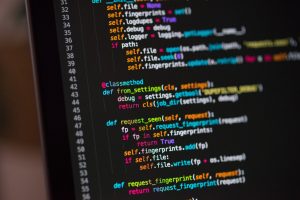
Today we learned a bit about coding by Rich McCue (website: http://richmccue.com/)! There’s a few different sites that help first-timers learn the basics of coding. Some include:
Scratch – https://scratch.mit.edu/
Grasshopper – https://grasshopper.codes/
Hour of Code – https://hourofcode.com/ca
Code BC – http://codebc.ca/
My Focus
I explored Scratch, which is known to be a more visual and intuitive way to begin learning code. While easy to navigate, being a total beginner with code, I did find there was a learning curve, and I think in order to advance in this program I would need to either spend time watching instructional videos or consult Rich or Val. Here’s a photo of what I did today!
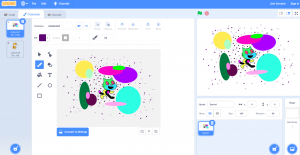
I developed a character, and had a lot of fun doing it. However, I didn’t get around to making the character move or speak. I would need some more help with this.
Overall
I could see this being a great introduction for students wanting to learn more about code, and for those who show interest in animation as there is some cross-over.
Learner Sharing Sessions
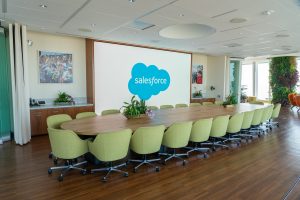 Today’s Class
Today’s Class
Today in Ed Tech we learned how to utilize technology to facilitate meetings if one or more people were not able to be in the room. This also extends beyond the university setting and can be applied to high schools.

Hypothetical Situation
As a class, we discussed the benefits of having access to this technology in a high school. Most high schools do have this capability, which is of huge benefit to students who may not feel comfortable coming to class for whatever reason. Say a student is sick, or has an injury and is unable to get to school on that day, they could access the classroom via camera technology. The same goes for an educator. If the educator is unable to attend the class, they could teach the class this way. This technology allows for a more accessible educational environment. It also provides an alternative option for students who may have long commutes to school and would prefer to only attend a couple times a week to mitigate the travel time.
Overall
I would use this in my classroom. Its a great way to have students and educators engaged and made to feel welcome in the classroom setting if they couldn’t be otherwise.
Minecraft in the Classroom
Today we had a brief introduction to Minecraft taught to us by Colquitz Middle School teacher Heidi James and her students. They did a great job! They walked us through how to join a Minecraft game, and then we had half the class to play the game. I did a lot of exploring of the landscape, collected fruits, fought a zombie, steered a boat in water, and climbed up really tall structures my classmates had built. While it was entertaining for some and I can see how some people would love it, I don’t think it’s for me.
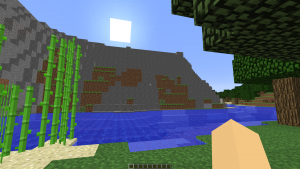 Here is a screenshot of the Minecraft world I was in. Moments earlier there was a giant squid in the water! Apparently, as a Minecraft character, you can get ink from the squid. I tried, but no luck 🙁
Here is a screenshot of the Minecraft world I was in. Moments earlier there was a giant squid in the water! Apparently, as a Minecraft character, you can get ink from the squid. I tried, but no luck 🙁
Uses of Minecraft
While you can’t get too specific with Minecraft features, it is possible to use it to learn general information in a subject. For example, if you were teaching a gardening class you could use Minecraft to map out the structure of the garden, and what vegetables would go where. However, you would be limited to a certain few vegetables, so there may be veggies that you would want to include in your actual garden that couldn’t be put into the Minecraft garden.
I also learned that the Colquitz class had used Minecraft as a way to learn about ancient civilizations. How cool! In this way, I could see MInecraft being very useful in the classroom as it gives students an interactive way to learn about and discover a past civilization.
Things I Noticed While Playing Minecraft
– most people were really engaged with the game
– my peers who had previous experience with Minecraft were helping those who didn’t
– there was lots of laughter and excitement in the room; we were having fun!
– I felt a little nauseous after playing for about 25 minutes straight 🙁
Interesting Sources to Check Out
– https://www.educationworld.com/a_tech/benefits-minecraft-classroom-students.shtml
– https://www.minecraft.net/en-us/
– a video of educators speaking about the uses of Minecraft in education
Remix Manifesto Thoughts
What is Remix Manifesto?
A documentary exploring copyright and content creation, focusing on the electronic music artist, Girl Talk, who’s music is a unique blend of old and new music mash ups.
Here’s a trailer:
Here’s a link to the full movie: http://https://www.nfb.ca/film/rip_a_remix_manifesto/
The film had me pondering…
The greed that comes with fame, and how even the slightest sampling of an original song can be cause for a law suit and copyright battles. I also found it interesting to compare Girl Talk’s take on electronic music production and sampling to other artists who work more “underground” in the electronic music world. Sampling happens all the time, and more often than not most producers are totally fine with other artists incorporating their work into a mix, or a DJ set. Maybe this is because in smaller communities there is a general understanding that artists support other artists; they’re all in it together. Sampling another artist’s track in your work isn’t necessarily seen as “stealing” or something that must be paid for in order to do. It’s more about sharing.
In Girl Talk’s case, he’s working with some pretty big hits. I guess that’s where the problem lies. The sheer popularity of the songs he’s mixing and the audience to which he plays his music changes the entire concept. It is no longer seen as “sharing”, but rather, “stealing”. This makes me think about something the artist Emily Carr once said, “cities make people sick”. While I take that with a grain of salt, I do understand what she means and how this could be used an an analogy to describe what happens when music goes “mainstream”.
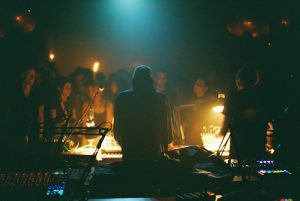 When Music Becomes Popular
When Music Becomes Popular
When music goes mainstream and sways away from the small communities it used to be part of it loses its ability to remain a shared resource. It now sits on a pedestal instead of being amongst its original community. While there’s benefits to this, such as financial gain and popularity, it also has its down side. It moves itself outside of the community which originally supported its sharing and connection. There are rules on the pedestal. Sharing isn’t encouraged; and the audience has changed, too.
Final Thoughts
I wonder what would happen if Girl Talk incorporated underground electronic music into his work? Maybe his crowd would change. Maybe he’d have to worry less about copyright. Would underground producers allow him to use their work for free?
Ed Camp Reflection
In today’s EDCI 336 class we had the chance to do a mock version of an Ed Camp. Ed Camp is a teacher-created discussion session, formed by the interests of the people in the room. In Ed Camp, there everyone is one the same level and there is no main presenter, and no slide shows. These group discussions are meant to be learner driven by those in the room who share their experience and expertise on the discussed topics.
Here’s a link to the Ed Camp website —> https://www.edcamp.org/
Our Mock Ed Camp
Our group discussed who our favourite teacher was in high school and why. There was a common thread amongst our group; that our favourite instructors were those who…
1) did things differently/weren’t afraid to break out of the traditional mold of teaching
2) were kind and genuinely believed and supported our growth and success as both a student and an individual
Personal Thoughts
These two attributes were things that brought us closer to ourselves and our teachers, which in turn created a more inclusive and diverse learning environment. For myself, school was a struggle. I didn’t enjoy the day to day routine, long days, and never ending homework load. Added on top of that was, for the most part, boring class time caused by teachers who didn’t include creativity or unconventionality in their classrooms. Being a creative and slightly unconventional person, I felt unsupported and crushed by my high school environment. The teachers that stood out to me were those who brought elements of theatre in their classrooms and weren’t afraid to think outside the box and encourage their students to do so, too. This made me feel like I was welcome somewhere; that my different way of thinking and being was accepted by at least someone in the school environment. It made me feel less alone and awkward, especially when I saw how well received the teacher’s teaching was taken by other classmates. It gave me the self esteem I needed to fell comfortable in my own skin.
Climate Strike Week 2 (The BIG one!)
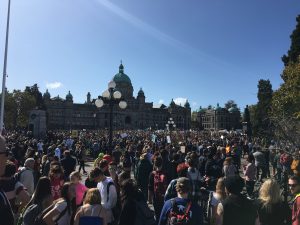
Global Climate Strike: 20,000 Strong!
On Friday, September 27th, I had the opportunity to attend the main Global Climate Strike event. I attended, with an estimated 20,000 other people, to march in solidarity for the environment and its inhabitants. Having attend the first climate strike in Victoria last Friday, I can say the turn out this time had a much wider reaching effect as far as size and energy goes – not that the last strike wasn’t effective, it was just much smaller. I also ran into at least 10 familiar faces, half of which were from my UVic cohort. Yes!!! I had been disappointed last week when none of my cohort showed up at the strike, and had my fingers crossed to see some at this event.

What it Meant to Me
This strike really opened my eyes to the amount of people who are concerned about the climate crisis. It felt really good to be around like-minded people in that sense, and know t
hat something very important to me was shared with thousands of others. I feel like it is not uncommon to feel as though talking about climate change is a taboo subject that shouldn’t be discusses with everyone – kind of like politics (and it is political!). This strike made me feel supported in my belief, and it gave me great hope that we can pull through as a society if we can come together to create change.
So Many Young Ones!
I was also really taken aback, and may have shed a tear or two, when the amount of youth/child attendees registered in my brain. When I was in high school, ten years ago, most of mypeers AND MY TEACHERS scoffed or laughed at me when I passionately addressed the topic during class discussion. I was labelled as “the hippie” and “the activist”, not just seen for caring about something very important to all beings. This left me with a great amount of anger and feeling of disconnection to those around me, but it also fuelled me to keep educating myself and having difficult discussions with others who had different beliefs. To see so many youth involved and passionate about climate justice / environmentalism really gave me hope that we are moving forward as a society. However, I still do have a great deal of climate anxiety, and much of this is the result of very real, sad truths.
A Final N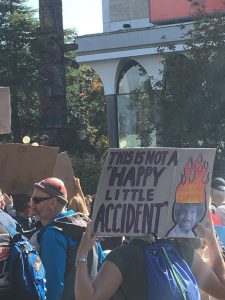 ote on Loss and Educating Climate Deniers
ote on Loss and Educating Climate Deniers
I take climate change very seriously. As inspiring and exciting as this issue was, it also came with some sadness. I made the decision to un-friend a friend of over 10 years because of their denial of climate change and decision to support the Conservative leader Andrew Scheer. While I feel great loss because of this, I just cannot understand how someone could deny climate change as it is a very real, and happening crisis. In the near future I will reach out to this friend and see if a conversation about the issue is possible. I have to go prepared, however, as the conversation will be a long one and likely heated. Has anyone else been in this, or a similar, position? How did you approach it? did you approach it?
Climate Strike Week 1
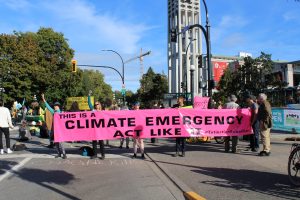
First Climate Strike
On Friday, Sept 20th, I attended the first climate strike in Victoria of the global climate strike week! We blocked the intersection at Belleville and Government to peacefully protest for the earth and its many inhabitants. We were there to support the global climate strikers worldwide, the environment, and indigenous peoples who’s communities and ways of life are being affected by this crisis.
Why I Attended
As a participant and an observer, I was able to see the reasons for activists showing up and spearheading the event. There were different speakers who expressed their desire, and the dire need, to move away from fossil fuels. They did so through theatre, music, traditional speech, poetry, and dance. There were first nations speakers who expressed their concern about the impacts of a pipeline being built through their communities, and how this will negative effect some food sources they rely upon. I attended this strike to educate myself and stand in solidarity. As an environmentally conscious person, I had to be there. I really love this earth; its landscapes, animals, and most of the people who inhabit it. I want to be a part of the change towards a cleaner world, and if we can’t get there I can be content knowing that I tried to make it possible.
I wish I had seen more people from my cohort there. Although, many folks didn’t realize the strike had started. I think many people thought it was only on Friday, September 27th. As an educator, I really believe that it’s my duty to show up as an ally for the environment, and any one else who needs support in this crisis.
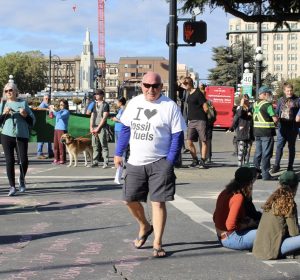
A Note on the Haters
While at the protest I was also able to create a little chalk art piece. Creating this gave me insight into some opposing views of climate change, and the types of aggression that accompany it. Some people walked over my chalk art piece, stomped on it while I was working, scoffed and swore at it and myself, and whispered passive aggressive phrases at me under their breath while walking by. It really is interesting how much hate some people have towards those who are trying to make the world a better place. I would love to have the opportunity to discuss with them why they have such anger and hatred towards environmentalist types. In the past when I’ve tried this, I am often met with hostility, so I didn’t engage this time. There was also a man who was wearing a shirt that read, “I LOVE FOSSIL FUELS”. He marched around the protest, smiling, challenging mostly younger students on their beliefs. Metaphorically, this man represented what we are fighting in the world – the insertion of ignorance and denial into a peaceful gathering of live beings.
- Verbal consent to use photos for this online class blog was provided by those in the photos
